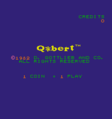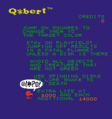Template:All Game Nav Template:Infobox
Q*Bert was the collaboration of artist Jeff Lee, programmer Warren Davis, and sound engineer David Thiel. Like many early game concepts, Q*Bert staretd out much differently than the eventual form in which it was released. But the result was a very innovative and fun game that did very well in the arcades. It contained a variety of features, ranging from the pseudo-3D look of the pyramid, to the physical knock sound generated from pinball hardware whenever the player fell off of the pyramid, and the famous unintelligable Q*Bert swearing that he uttered when he collided with an enemy.
In 1982, Parker Brothers was determined to become a major player in the video game industry. As such, they joined the race with Atari, and later Coleco, to acquire the home conversion rights to several popular arcade hits. Along with Frogger and Popeye, they scored the rights to release Q*Bert for home systems and computers. In 1983, when Nintendo launched the Famicom in Japan, Popeye was one of the first three games made available for the system. In 1989, Konami released the game for the NES under the Ultra Games label.
Since then, the Q*Bert license has been brought back like many classic gaming icons. Updated versions have appeared on the Game Boy, Super Nintendo, PlayStation, Sega Dreamcast and the PC. The last three editions were a 3D version produced by Hasbro Interactive.
-
Title screen.
-
In-game instructions.
Story
Like many of the earliest video games, there is no distinct reason provided as to why Q*Bert must jump all over multiple pyramids and change the color of every block top. It is simply your job to guide him safely through each stage, avoid all the enemies who would like to stop him in his quest.
Table of Contents
Walkthrough
Box artwork
Throughout its many releases, Q*Bert has accumulated a large collection of different pieces of artwork for the game boxes. Some are shown below:
-
Atari 2600 (Parker Brothers)
-
Atari 2600 (Atari)
-
Atari 5200
-
Atari 800
-
Odyssey2
-
Intellivision
-
Colecovision
-
TI 99/4a
-
Commodore VIC-20
-
Commodore 64
-
Sega SG-1000 (Japan)
-
NES














